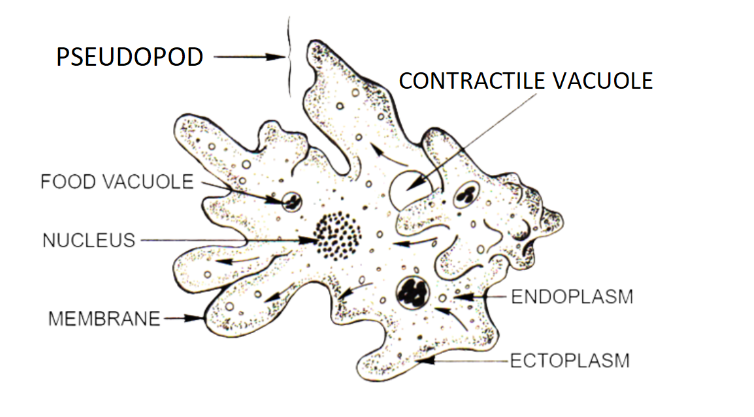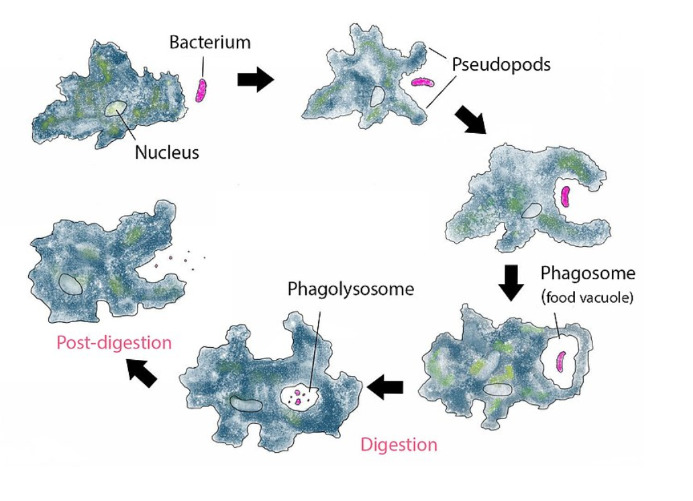Table of Contents
Introduction
Amoeba is a type of microscopic organism belonging to the kingdom Protista. It is a unicellular organism that exhibits several distinct characteristics. Amoebas are classified under the phylum Amoebozoa and are commonly found in various aquatic environments such as freshwater, soil, and marine environments.
| Amoeba Classification | |
| Domain | Eukaryota |
| Kingdom | Protista |
| Phylum | Amoebozoa |
| Class | Tubulinea |
| Order | Euamoebida |
| Family | Amoebidae |
| Genus | Amoeba |
Structure of Amoeba

Nutrition in amoeba
Nutrition is the science and study of how nutrients in food are processed, metabolized, and utilized by the body for growth, development, and maintenance of overall health. It encompasses the study of nutrients, their functions, and their effects on the body, as well as the process of food digestion, absorption, and the body’s utilization of nutrients for energy and various physiological processes.
Nutrition in amoeba is quite different from nutrition in multicellular organisms. Amoebas are single-celled organisms that belong to the group of protists. They obtain nutrients through a process called phagocytosis.
Amoebas are heterotrophic organisms, meaning they cannot produce their own food through photosynthesis like plants. Instead, they rely on external food sources for their nutrition. Amoebas primarily feed on microscopic organisms such as bacteria, algae, and other small protozoans.
Holozoic nutrition is a type of nutrition found in many amoeba, including humans. It involves the ingestion of complex, solid food particles, which are then broken down into smaller pieces through mechanical and chemical digestion. The digested nutrients are absorbed and utilized by the organism for energy, growth, and various metabolic processes.
Holozoic nutrition typically follows a series of steps
- Ingestion: The amoeba captures or consumes solid food through various methods, such as biting, chewing, or engulfing. The food may include plant or amoeba matter.
- Digestion: Once ingested, the food undergoes mechanical and chemical digestion. Mechanical digestion involves the physical breakdown of food through actions like chewing or grinding, while chemical digestion involves the release of enzymes that break down complex molecules into simpler forms. Digestion can occur in specialized digestive organs, such as the stomach and intestines, or within specialized compartments, like the food vacuoles in protozoans.
- Absorption: After digestion, the nutrients derived from the breakdown of food are absorbed by the amoeba’s body. This absorption usually takes place in the small intestine, where the nutrients are transported across the intestinal lining and into the bloodstream.
- Assimilation and Utilization: Once absorbed, the nutrients are transported to various cells and tissues throughout the body. They are assimilated into the organism’s own cells and utilized for energy production, growth, repair, and other metabolic processes.
- Egestion: Any undigested or indigestible material, along with waste products, is eliminated from the body through the process of egestion. This typically occurs through the rectum and anus in amoeba with a complete digestive system.
Holozoic nutrition allows amoeba to obtain a wide range of nutrients required for their survival and growth. It is more complex than other forms of nutrition, such as autotrophic nutrition (photosynthesis in plants) or saprophytic nutrition (obtaining nutrients from dead organic matter). Holozoic organisms have specialized organs or structures, such as teeth, jaws, and digestive systems, to facilitate the ingestion, digestion, and absorption of solid food.

Amoebas do not possess a specialized digestive system like multicellular organisms. Instead, the entire cell acts as a site for digestion and absorption of nutrients. They can engulf food particles that are as large as or even larger than their own size, thanks to their flexible cell membrane and the ability to form pseudopodia.
Phagocytosis
Phagocytosis is a cellular process by which cells engulf and internalize solid particles, such as bacteria, dead cells, or food particles. It is a critical mechanism for nutrient acquisition, immune defense, and waste removal in various organisms, including amoebas, macrophages, and certain white blood cells.
The process of phagocytosis involves several steps:
- Chemotaxis: The cell detects the presence of a particle through chemical signals released by the particle or other cells. These chemical signals attract the cell towards the particle, guiding it to the site of phagocytosis.
- Recognition and Attachment: The cell’s surface receptors recognize specific molecules on the surface of the particle, marking it as a target for engulfment. The cell extends protrusions called pseudopodia to surround the particle, bringing it close to the cell membrane.
- Engulfment: The pseudopodia continue to extend and wrap around the particle, eventually fusing together to form a phagosome. The phagosome is a membrane-bound vesicle that encloses the particle within the cell.
- Phagosome Maturation: The phagosome undergoes a series of maturation processes, including fusion with lysosomes or endosomes. This fusion forms a phagolysosome, which contains digestive enzymes and other molecules required for digestion.
- Digestion: Within the phagolysosome, the particle is subjected to the action of digestive enzymes. These enzymes break down the particle into smaller molecules, such as proteins, lipids, and sugars, which can be utilized by the cell.
- Absorption and Utilization: The digested molecules are absorbed across the phagolysosome membrane into the cytoplasm of the cell. They are then utilized for energy production, growth, repair, or other cellular processes.
- Exocytosis: Any undigested material or waste products remaining in the phagolysosome can be eliminated from the cell through exocytosis. The phagolysosome fuses with the cell membrane, expelling its contents outside the cell.
Phagocytosis plays a crucial role in various biological processes, including immune response, nutrient acquisition, tissue remodeling, and defense against pathogens. It is an essential mechanism for cells to ingest and process solid particles, allowing them to maintain homeostasis and perform their specialized functions.
Overall, nutrition in amoeba involves the capture, digestion, absorption, and egestion of food particles, enabling the organism to obtain the necessary nutrients for survival and growth.
FAQs on Nutrition in Amoeba
How does amoeba obtain nutrition?
Amoebas obtain nutrition through a process called phagocytosis. They extend their pseudopodia to engulf and surround food particles, such as bacteria or other small organisms, forming a food vacuole. Digestion then occurs within the vacuole.
What type of nutrition does amoeba exhibit?
Amoeba exhibits phagotrophic nutrition, which involves the ingestion of solid food particles through phagocytosis.
What kind of food does amoeba eat?
Amoebas primarily feed on microscopic organisms, including bacteria, algae, and other small protozoans, as their food source.
How does amoeba digest its food?
Amoebas release enzymes into the food vacuole, where the ingested particles are enclosed. These enzymes aid in the extracellular digestion of the food, breaking it down into simpler substances.
How does amoeba absorb nutrients?
Once the food is digested, the nutrients are absorbed across the membrane of the food vacuole and into the cytoplasm of the amoeba. From there, the nutrients are utilized for energy production and other metabolic processes.
Can amoeba engulf large food particles?
Yes, amoebas can engulf food particles that are as large as or even larger than their own size. Their flexible cell membrane and the ability to form pseudopodia allow them to capture and engulf relatively large prey.
How does amoeba eliminate waste products?
Any undigested or indigestible material, along with waste products, is eliminated from the amoeba's body through a process called exocytosis. The waste material is expelled from the cell through the membrane.
What happens if amoeba doesn't find food?
When amoebas are unable to find food, they can form a protective cyst or become dormant until favorable conditions, including the availability of food, are restored.
Can amoebas survive without a constant food supply?
Amoebas can survive for extended periods without a constant food supply by utilizing stored energy reserves within their cytoplasm. They can remain dormant or enter a resting state until they encounter a food source.









